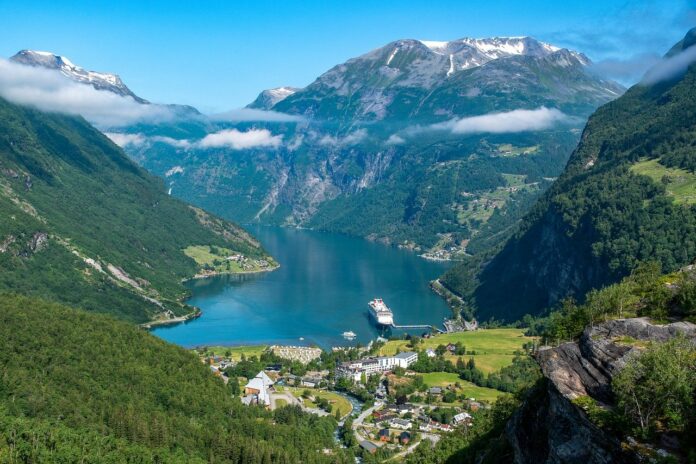25 Interesting Facts About Norway
- Location and Borders: Norway is located in Northern Europe on the Scandinavian Peninsula. It is bordered by Sweden to the east, Finland to the northeast, and Russia to the far northeast. To the west, Norway has an extensive coastline along the North Atlantic Ocean and the Barents Sea.
- Square: The country covers an area of approximately 148,729 square kilometers.
- National Currency: The currency of Norway is the Norwegian Krone (NOK).
Interesting Facts About Norway:
- Population and Urbanization: Norway has a population of less than 5 million people, with more than 1.5 million residing in the capital, Oslo, and its suburbs. Any city with a population over 30,000 is considered large. About 80% of Norwegians live in urban areas, with 85% concentrated in the eastern and southern regions.
- Parental Leave: Ninety percent of Norwegian fathers take 12 weeks of paternity leave to care for their newborns, reflecting the country’s progressive family policies.
- Free Education: Local public universities in Norway offer free education to all citizens, emphasizing the country’s commitment to accessible education.
- Minnesota Connection: Minnesota is considered the unofficial Norwegian capital in the United States, with a higher concentration of people of Norwegian descent than any other state.
- Educational Attainment: Approximately 37% of Norwegians hold a higher education degree, making Norway the most educated country in Europe.
- Ancient Settlement: Since the end of the Ice Age, modern Norway has been one of the most densely populated areas on the planet.
- Cleanliness and Ecology: Finding litter on the streets of Norwegian cities is nearly impossible due to the citizens’ dedication to cleanliness and environmental care.
- Property and Design: Norwegian homes, often appearing magnificent, reflect a high standard of living and attention to design. Real estate is very expensive in Norway.
- Health Habits: Many Norwegians consume a tablespoon of fish oil daily for health benefits, particularly to prevent rickets in children.
- Cycling Culture: Bicycles are a primary mode of transportation in Norway, enjoyed by residents in all weather conditions.
- Proximity to Water: Norwegians prefer living close to water, with city dwellers often owning homes by the sea. More than half of the population owns boats.
- High-Speed Internet: Nearly 100% of Norwegians have access to high-speed internet, crucial for communication due to the climate and distances.
- Economic Transformation: In the mid-20th century, Norway was not among Europe’s wealthiest countries. The oil boom changed this, with the country investing oil revenues in various sectors, including agriculture.
- Recycling Initiatives: Norwegian stores feature machines for recycling plastic, glass bottles, and aluminum cans. In exchange for recyclables, customers receive vouchers that can be used for shopping.
- Languages: Norway has three national languages: Bokmål, Nynorsk, and Sami. Additionally, nearly all Norwegians are fluent in English.
- Lærdal Tunnel: The Lærdal Tunnel on the E16 is the world’s longest road tunnel, stretching 24.5 kilometers (15.2 miles). It is a standard two-lane road.
- High Cost of Living: Grocery prices are very high in Norway. Some supermarkets offer discounts of up to 50% on items close to their expiration date.
- Income: The average monthly salary in Norway is 40,800 kroner (approximately 303,700 rubles) for men and 34,800 kroner (approximately 259,000 rubles) for women.
- Social Equality: Norway consistently ranks high in global indices for equality, happiness, and quality of life, making it one of the best countries to live in.
- Natural Beauty: Known for its breathtaking landscapes, Norway boasts famous fjords, northern lights, and midnight sun, attracting nature enthusiasts and tourists from around the world.
- Viking Heritage: Norway has a rich Viking history, with numerous archaeological sites, museums, and cultural heritage centers dedicated to preserving and showcasing this legacy.
- Renewable Energy: Norway is a leader in renewable energy, with the majority of its electricity generated from hydroelectric power, contributing to its low carbon footprint.
- Cuisine: Traditional Norwegian cuisine includes seafood, game meats, and hearty stews, with dishes like rakfisk (fermented fish) and lutefisk (dried fish treated with lye) being unique to the region.
- Midnight Sun and Polar Nights: In northern Norway, the sun does not set for about two months during summer (midnight sun), and conversely, it does not rise for about two months during winter (polar nights), creating unique living conditions.
- Sporting Achievements: Norway excels in winter sports, often leading the medal tally in the Winter Olympics, thanks to its favorable climate and terrain for activities like skiing and ice skating.
